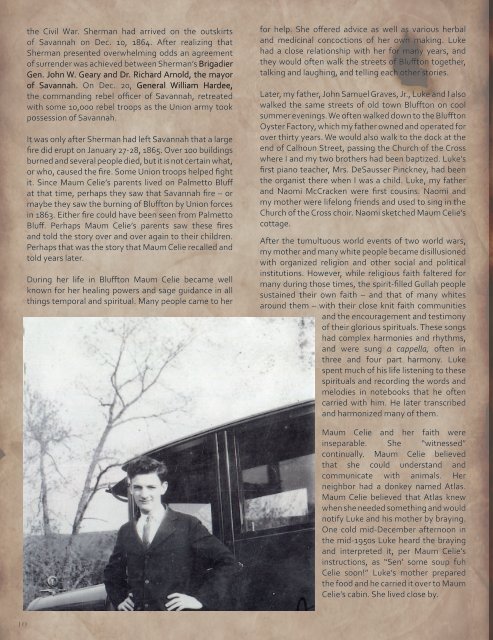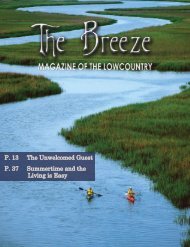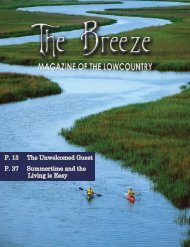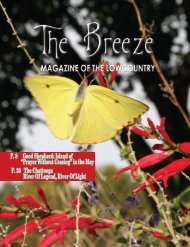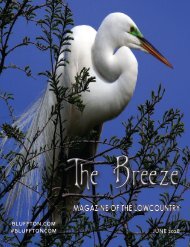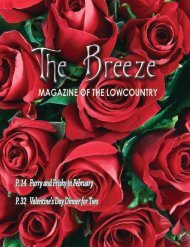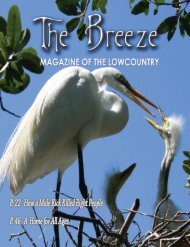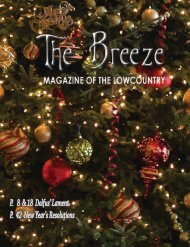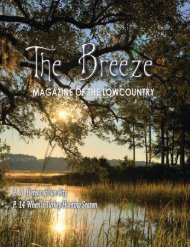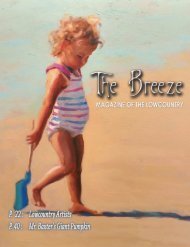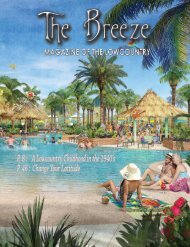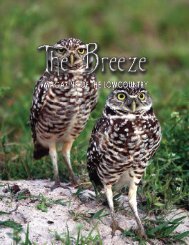The Breeze Magazine of the Lowcountry, MARCH 2019
You also want an ePaper? Increase the reach of your titles
YUMPU automatically turns print PDFs into web optimized ePapers that Google loves.
<strong>the</strong> Civil War. Sherman had arrived on <strong>the</strong> outskirts<br />
<strong>of</strong> Savannah on Dec. 10, 1864. After realizing that<br />
Sherman presented overwhelming odds an agreement<br />
<strong>of</strong> surrender was achieved between Sherman’s Brigadier<br />
Gen. John W. Geary and Dr. Richard Arnold, <strong>the</strong> mayor<br />
<strong>of</strong> Savannah. On Dec. 20, General William Hardee,<br />
<strong>the</strong> commanding rebel <strong>of</strong>ficer <strong>of</strong> Savannah, retreated<br />
with some 10,000 rebel troops as <strong>the</strong> Union army took<br />
possession <strong>of</strong> Savannah.<br />
It was only after Sherman had left Savannah that a large<br />
fire did erupt on January 27-28, 1865. Over 100 buildings<br />
burned and several people died, but it is not certain what,<br />
or who, caused <strong>the</strong> fire. Some Union troops helped fight<br />
it. Since Maum Celie’s parents lived on Palmetto Bluff<br />
at that time, perhaps <strong>the</strong>y saw that Savannah fire – or<br />
maybe <strong>the</strong>y saw <strong>the</strong> burning <strong>of</strong> Bluffton by Union forces<br />
in 1863. Ei<strong>the</strong>r fire could have been seen from Palmetto<br />
Bluff. Perhaps Maum Celie’s parents saw <strong>the</strong>se fires<br />
and told <strong>the</strong> story over and over again to <strong>the</strong>ir children.<br />
Perhaps that was <strong>the</strong> story that Maum Celie recalled and<br />
told years later.<br />
During her life in Bluffton Maum Celie became well<br />
known for her healing powers and sage guidance in all<br />
things temporal and spiritual. Many people came to her<br />
for help. She <strong>of</strong>fered advice as well as various herbal<br />
and medicinal concoctions <strong>of</strong> her own making. Luke<br />
had a close relationship with her for many years, and<br />
<strong>the</strong>y would <strong>of</strong>ten walk <strong>the</strong> streets <strong>of</strong> Bluffton toge<strong>the</strong>r,<br />
talking and laughing, and telling each o<strong>the</strong>r stories.<br />
Later, my fa<strong>the</strong>r, John Samuel Graves, Jr., Luke and I also<br />
walked <strong>the</strong> same streets <strong>of</strong> old town Bluffton on cool<br />
summer evenings. We <strong>of</strong>ten walked down to <strong>the</strong> Bluffton<br />
Oyster Factory, which my fa<strong>the</strong>r owned and operated for<br />
over thirty years. We would also walk to <strong>the</strong> dock at <strong>the</strong><br />
end <strong>of</strong> Calhoun Street, passing <strong>the</strong> Church <strong>of</strong> <strong>the</strong> Cross<br />
where I and my two bro<strong>the</strong>rs had been baptized. Luke’s<br />
first piano teacher, Mrs. DeSausser Pinckney, had been<br />
<strong>the</strong> organist <strong>the</strong>re when I was a child. Luke, my fa<strong>the</strong>r<br />
and Naomi McCracken were first cousins. Naomi and<br />
my mo<strong>the</strong>r were lifelong friends and used to sing in <strong>the</strong><br />
Church <strong>of</strong> <strong>the</strong> Cross choir. Naomi sketched Maum Celie’s<br />
cottage.<br />
After <strong>the</strong> tumultuous world events <strong>of</strong> two world wars,<br />
my mo<strong>the</strong>r and many white people became disillusioned<br />
with organized religion and o<strong>the</strong>r social and political<br />
institutions. However, while religious faith faltered for<br />
many during those times, <strong>the</strong> spirit-filled Gullah people<br />
sustained <strong>the</strong>ir own faith – and that <strong>of</strong> many whites<br />
around <strong>the</strong>m – with <strong>the</strong>ir close knit faith communities<br />
and <strong>the</strong> encouragement and testimony<br />
<strong>of</strong> <strong>the</strong>ir glorious spirituals. <strong>The</strong>se songs<br />
had complex harmonies and rhythms,<br />
and were sung a cappella, <strong>of</strong>ten in<br />
three and four part harmony. Luke<br />
spent much <strong>of</strong> his life listening to <strong>the</strong>se<br />
spirituals and recording <strong>the</strong> words and<br />
melodies in notebooks that he <strong>of</strong>ten<br />
carried with him. He later transcribed<br />
and harmonized many <strong>of</strong> <strong>the</strong>m.<br />
Maum Celie and her faith were<br />
inseparable. She “witnessed”<br />
continually. Maum Celie believed<br />
that she could understand and<br />
communicate with animals. Her<br />
neighbor had a donkey named Atlas.<br />
Maum Celie believed that Atlas knew<br />
when she needed something and would<br />
notify Luke and his mo<strong>the</strong>r by braying.<br />
One cold mid-December afternoon in<br />
<strong>the</strong> mid-1950s Luke heard <strong>the</strong> braying<br />
and interpreted it, per Maum Celie’s<br />
instructions, as “Sen’ some soup fuh<br />
Celie soon!” Luke’s mo<strong>the</strong>r prepared<br />
<strong>the</strong> food and he carried it over to Maum<br />
Celie’s cabin. She lived close by.<br />
10


